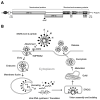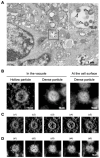Electron Tomography as a Tool to Study SARS-CoV-2 Morphology
- PMID: 39519314
- PMCID: PMC11547116
- DOI: 10.3390/ijms252111762
Electron Tomography as a Tool to Study SARS-CoV-2 Morphology
Abstract
Severe acute respiratory syndrome coronavirus 2 (SARS-CoV-2), a novel betacoronavirus, is the causative agent of COVID-19, which has caused economic and social disruption worldwide. To date, many drugs and vaccines have been developed for the treatment and prevention of COVID-19 and have effectively controlled the global epidemic of SARS-CoV-2. However, SARS-CoV-2 is highly mutable, leading to the emergence of new variants that may counteract current therapeutic measures. Electron microscopy (EM) is a valuable technique for obtaining ultrastructural information about the intracellular process of virus replication. In particular, EM allows us to visualize the morphological and subcellular changes during virion formation, which would provide a promising avenue for the development of antiviral agents effective against new SARS-CoV-2 variants. In this review, we present our recent findings using transmission electron microscopy (TEM) combined with electron tomography (ET) to reveal the morphologically distinct types of SARS-CoV-2 particles, demonstrating that TEM and ET are valuable tools for visually understanding the maturation status of SARS-CoV-2 in infected cells. This review also discusses the application of EM analysis to the evaluation of genetically engineered RNA viruses.
Keywords: SARS-CoV-2; electron microscopy; electron tomography; morphogenesis; three-dimensional reconstruction; transmission electron microscopy; virus budding.
Conflict of interest statement
The authors declare no conflict of interest.
Figures





References
-
- Wu C., Chen X., Cai Y., Xia J., Zhou X., Xu S., Huang H., Zhang L., Zhou X., Du C., et al. Risk Factors Associated with Acute Respiratory Distress Syndrome and Death in Patients With Coronavirus Disease 2019 Pneumonia in Wuhan, China. JAMA Intern. Med. 2020;180:934–943. doi: 10.1001/jamainternmed.2020.0994. - DOI - PMC - PubMed
-
- WHO Coronavirus Disease (COVID-19) [(accessed on 1 August 2024)]. Available online: https://www.who.int/emergencies/diseases/novel-coronavirus-2019.
-
- WHO Director-General’s Opening Remarks at the Media Briefing—5 May 2023. [(accessed on 28 October 2024)]. Available online: https://www.who.int/director-general/speeches/detail/who-director-genera....
Publication types
MeSH terms
Supplementary concepts
LinkOut - more resources
Full Text Sources
Medical
Miscellaneous

